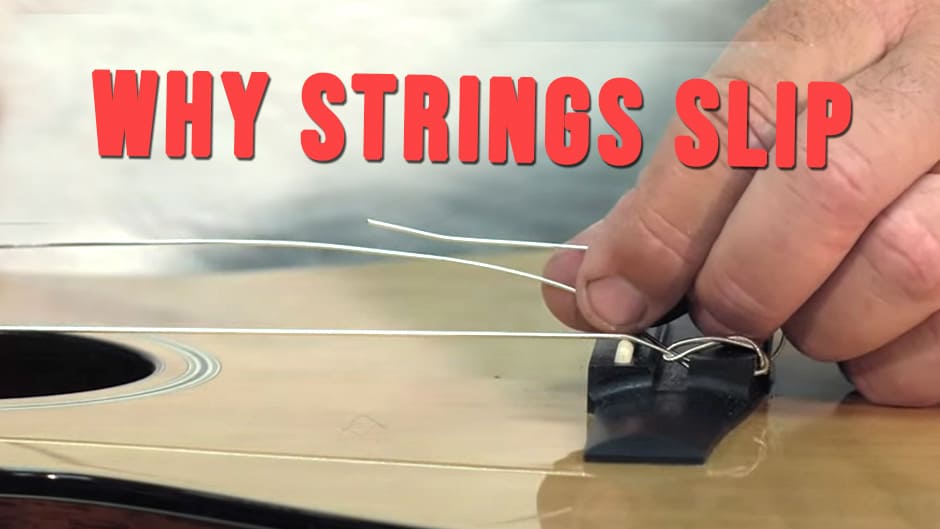It happens to every classical guitar player at some time. As you re-string your guitar and bring it up to pitch, the tightening string suddenly ‘slips’ and loses its tension and pitch. In worst cases, the string comes free of its knot at the bridge with such force that it nicks the soundboard with a visible gash – an event poetically known as a ‘string ding’.
Why does a classical guitar string slip while tuning? String slippage occurs at the headstock end when a string is tied insecurely over the capstan. String slippage at the bridge end occurs mainly with treble strings, particularly carbon, and if nylon, it is invariably the first (E) string. The reason is that both the nylon E string and the carbon trebles are thinner in diameter than other strings and smoother in texture. Being thin and smooth causes these strings to unravel at the bridge when the tension is increased by turning the tuning pegs even though the knotting may have been proper.
I remember my first foray into the exciting world of carbon strings. I put on the first string (E treble) with the bridge knot tied in my usual pattern practiced over many years. When I turned the tuning peg to tighten the string it just came undone like butter, or more like spaghetti being sucked in. It pulled itself out of the knot effortlessly. I already knew the carbons were physically of thinner diameter, and now I saw proof they were also smooth as butter/spaghetti. It is a heady combination to manage.
There are a few tricks to get this slippage issue resolved. But first – how can you tell if you have a problem at all?
Table of Contents
Telltale sign of the string that slips

Slipping is not to be confused with stretching. Stretching happens all the time with nylon strings, no matter the brand. You fix a new set of strings and when you bring them up to pitch, you stretch them. This is normal. In a few days, with some continual tuning, the strings will have stretched enough and then become stable.
Slipping is different. You are simply unable to tune the guitar when a string slips. The telltale sign before a slip is you wind the peg tauter and the pitch does not go up. If that happens, it’s time to stop the winding, back off the tension and check the tie. In some cases, you will hear the pitch actually drop even though you are winding up. Your string is slipping.
In extreme cases, the string unravels and cleanly comes off the tie block with suddenness and rapidity. Let’s tackle the easier issue first – the string slip happening at the headstock end of things.
When it slips at the headstock end…
This could happen to any of the six strings on the classical guitar, whether of nylon or carbon or anything else. The string slips at the knot in the tuner. The reason is always the same: an improper tying of the knot.
You have to untie the strings and do it again – properly. It’s good to ensure the windings are close to the string hole on the capstan and also that the windings are parallel. Most important, the method of tying the knot has to be a secure one. There isn’t one way that is the best; there are a handful of ways to get the knot right.
Here is one proper way to do it (among many excellent YouTube tutorials from reliable sources you can find online.) Pay special attention when he gets to the headstock end and explains the knot options to use there. This knot (or other variants just as secure) is the key to solving the issue.
This should take care of string slippage at the tuner.
Now for the knot at the bridge end
Most players use the regular thumb knot over the tie block with multiple loops.
The stringing video above explains this knotting at the bridge end very well. Some classical guitarists double-loop the B and G strings while triple looping the high E string for added security. A variation is to triple-loop all the 3 treble strings and double-loop the D and A strings. The low E string often tends to be too thick to be looped. (For extra, extra security, some folks loop the top E string four times.)
The extra looping comes in handy with the vulnerable first string (top E string) if it’s nylon and with all treble strings if they are carbon. Remember, fluorocarbons are slippery things that need to be curtailed.
One last, but an important, thing. Check if the last loop rests snugly against the tie block at its backside and not at the top. This is important. It’s about the only way to ensure you have locked the string in place. This instruction is clearer with a visual rather than a written description. See the D’Addario video above where the instructor explains this placement of the loop behind the tie block clearly.
In fact, during my first adventure with carbon strings mentioned above, this wrongful placement of the last loop on top of the tie block instead of the back was the key cause of the slippage. I figured out the correct placement with some trial and error, but it was a hard lesson learned.
The knot with extras attached
While a secure knot, as explained above, is secure enough for most folks, some go the extra yard.
They don’t stop at multiple wrapping the strings over the tie block, they also finish up with a figure of 8 knot at the end for added security. The figure of 8 knot, incidentally, is used in mountain climbing routinely, so it should be beyond criticism for use with a mere classical guitar.
Some folks lightly sand the string surface. Take coarse-grained sandpaper and fold it. Drag the last couple of inches of the string through the paper fold to roughen up the string. It’s not about shaving off the diameter but removing the slippery sheen.
There’s no stopping you if you wish to sandpaper the string ends as well as tie an additional knot for supreme insurance against slippage.
Burn the end to make a ball-end string
If you’ve never heard of this, it will come as a surprise. Use a lighter or a match to melt the string end (nylon works best) into a ball. That little bump at the end of the string will protect it from unraveling because it won’t be able to pass under its own coils. There is no way it can slip underneath the string now.
It’s an ingenious, if not adventurous, solution folks have been using for years, it seems. I’ve heard of a few who have been melting string ends for a few decades at least. It may appear excessive (if not dangerous) to be lighting fires next to one’s guitar. But, to be fair, you don’t need to be anywhere near your guitar to light up a fresh string.
Does the ball ever break off? Apparently not. Melting a small ball at the end of a string is added protection. There is no substitute for a well-tied string in the first place. The ball doesn’t replace the knot. With up to 3 loops of a thin, slippery carbon or titanium string, you should already be fine. The fireball just adds an additional layer of security.
Get yourself some string beads
You may or may not have heard of a minor accessory for classical guitars: little things called string beads, also known as string ties or tie blocks. They hardly cost a few dollars but one of their uses is that they convert your regular strings into ball-end strings of the type you find on acoustic guitars.
String beads certainly have the advantage of taking care of string slippage even with thin carbon strings. If you want more details and watch a video of how exactly they are affixed to the classical guitar, you can go to my article All About String Beads and get the full details.
_____________
On a related note, you can read my article on Why Classical Guitar Strings Go Out of Tune and What To Do About It. It looks at the notorious manner in which our beloved instrument needs constant attention and frequent tuning and how to break out of that cycle.
Happy stabilizing!
